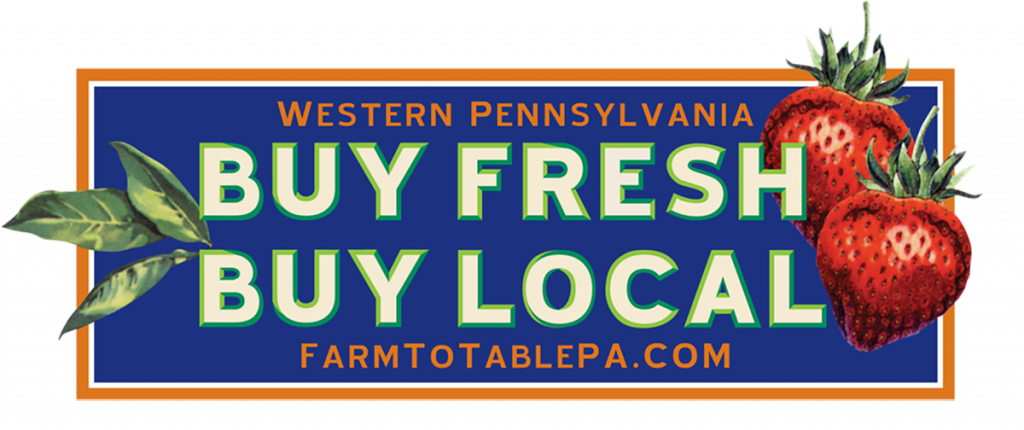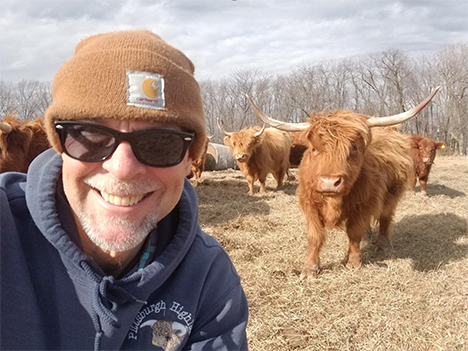Scottish Highland cattle have been around for a very long time and are prevalent in small and large herds throughout the United States and the word. We at Pittsburgher Highland Farm (PHF) started raising them in 2008, and they remain the central focus of what we do.
These furry creatures have attracted new and increased attention lately, as evidenced by the number of inquiries we’ve received about farm tours and purchasing live animals. We’re not sure what it’s all about, but the interest in Highlands seems to have been driven in part by COVID and the subsequent want of many folks to make better use of land and perhaps raise more of their own food. Highlands can help with both.
The breed itself evolved around the sixth century in the highland areas of Scotland as well as the islands off their west coast. The predominantly red (more akin to the mountains of Scotland) and black (more common on the islands) varieties adapted well to the often extreme weather conditions, challenging terrain, and relatively limited natural forages. The result of their evolution is exhibited by distinctive features generally not seen in other breeds of cattle like long hair and long horns.
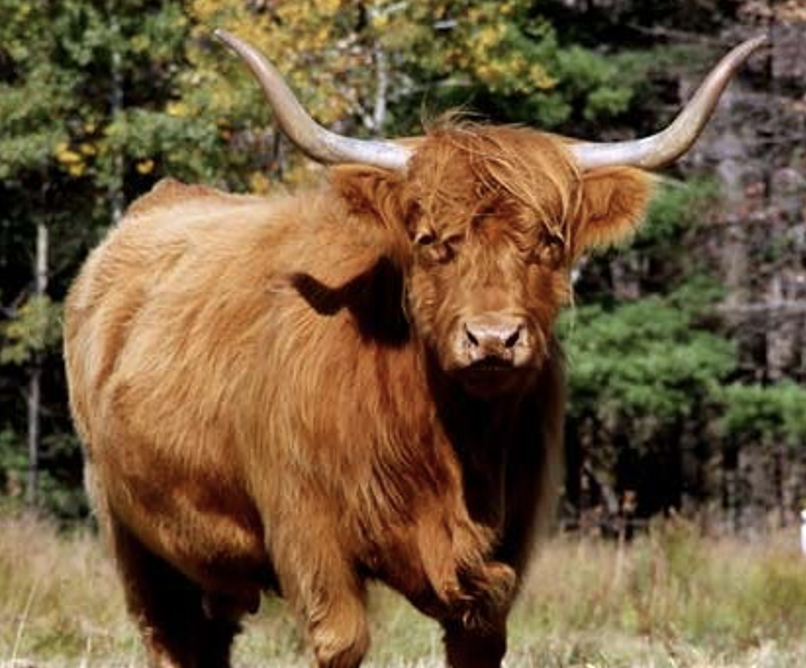
Heritage Breed
Highland cattle are one of a handful of “heritage” breeds, defined loosely by the Livestock Conservancy as those that have maintained their original genetic characteristics over of long history in the U.S. Numerous breeds have been genetically manipulated, especially in the U.S., to make them produce beef and milk more efficiently. This is most true of black Angus for beef and Holsteins for milk. Angus have been bred to gain weight quickly, especially when exposed to feedlot conditions and a grain-based diet, making them by far the most popular beef production breed in the U.S. Similarly Holsteins have been bred to maximize milk production.
John Ligo of Li Terra Farms in Grove City PA has crossbred Highlands and Angus cattle for many years and describes the defining difference between the two like this: “Angus have been bred to be the cattle that the commodity beef markets demand while Highlands are the same cattle that they’ve always been.” Highlands are, in fact, the ultimate heritage breed, as little about them has changed over hundreds of years.
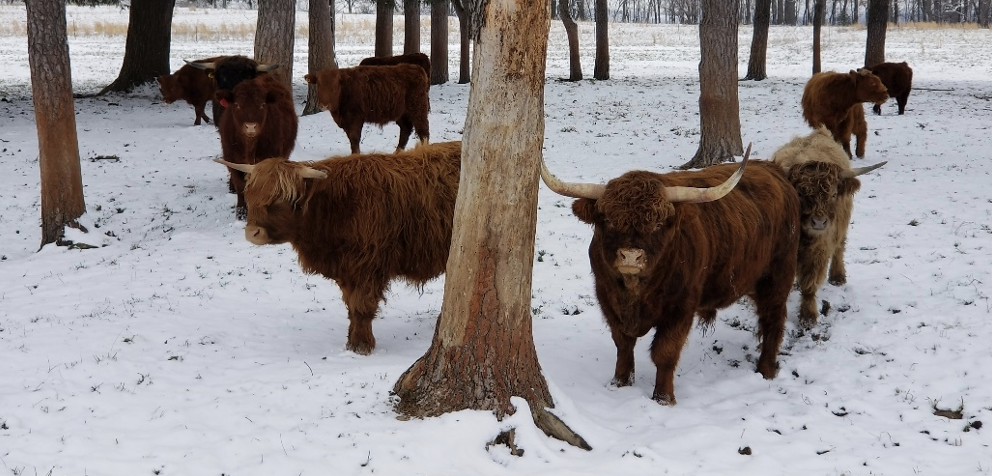
Built Tough
Everything that is advantageous about Highland cattle can be largely attributed to their development among the often harsh weather conditions, challenging topography, and limited and lower quality forages of the mountains and islands of northern Scotland. Here they learned the hard way how to survive and thrive, becoming excellent foragers (consumers of grass and legumes) and browsers (eaters of brush and brows). While at PHF we hardly force our cattle to survive on poor quality forages (quite the opposite, actually), it is a given that the Highland breed is more adept at maintenance on fewer and lower quality goodies if necessary. It’s just one of the traits that made them attractive to us when starting our herd, especially since our farm at the time was badly overgrown with invasive brush and brows. It would be an exaggeration to suggest that they eventually made the place look like a golf course (never the goal anyway), they did clear numerous areas over time for the establishment of better-quality pastures, forbs, and even better species of trees. We’ll discuss those trees in a later blog.
The harsh conditions and limited food sources available to this breed eventually made them an efficient source of food and drink to the hardy folks that domesticated them. Highland cattle to this day have proven their ability to turn less food (grass and hay) into tender, lean, and flavorful beef. Studies at both the University of Glasgow and, later, at the University of Missouri have confirmed through lab tests that Highland beef on average is more tender than commercial beef while higher in protein and iron and containing less cholesterol and fat. More beef using less feed is a beef producer’s dream. Healthier beef at competitive prices is a consumer’s dream. How lucky are we to have stumbled onto this unique critter!?
It further stands to reason that Highlands adapted to be a far hardier breed than most others, requiring less inputs (expensive feedstock, veterinary care, and shelter) than most other breeds. While all cattle were once this hardy, many breeds have been so tempered by genetic manipulation over time that their survival instincts have nearly disappeared. Not so the Highlands. We’re pretty sure that if people disappeared tomorrow from the planet, Highland cattle would eventually bust out of their domestic confines and find a way to survive. Rarely have we needed to call a vet or assist mamas with calving, and never have our cattle cared for the shelter of a barn or shed over their own instincts to guard against extreme weather conditions. That observation has convinced me that barns and other shelters, often a confined space rife with mud, manure, and parasites, have been created for our own convenience more than for the animals.
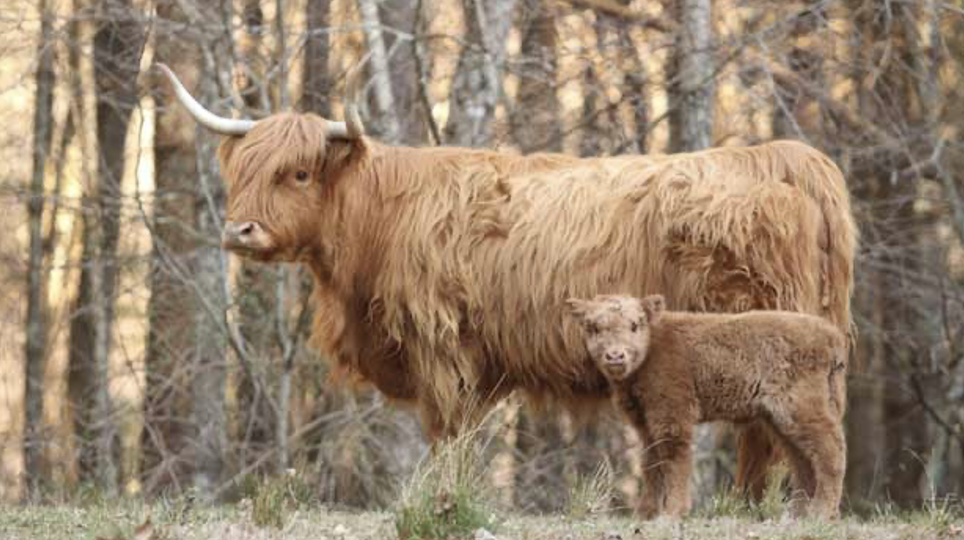
Performance
Data collected by the American Highland Cattle Association (AHCA) indicates that average birth weights among Highland cattle is 65 to 70 pounds, slightly less than most other breeds, with 98% of calvings recorded being unassisted. This means that no human help, including that of a veterinarian, was needed. Having grown up among Holsteins bred to be especially large, I lost count a long time ago the number of times we had to assist mamas giving birth or even call a vet to help.
While all cattle can exhibit “flighty” or even wild traits, Highlands are known to be docile when compared to other breeds. AHCA has collected data that indicates 80% of Highlands studied scoring as “exceptionally calm” or “calm” when handled. This makes life much easier for humans and animals alike. We believe that keeping our animals happy and adequately fed helps make them more relaxed and docile. I can honestly say that the only flighty or even nasty Highlands we’ve encountered over the years at PHF have been raised elsewhere and introduced as adults to our operation. We promptly cull such critters from the herd.
Great on Grass
All cattle are ruminants meant to live on a green diet of grass, legumes and forbs. Food industrialization, largely an American invention, has changed that in a big way, with about 95% of cattle produced here raised on corn and grain. A return to grass-fed beef on the part of many consumers has created a niche market for growers like us, and Highland cattle might just be the best breed to help meet the demands of that market.
Since cattle were always meant to eat grass, and Highlands have changed little in their evolution, it stands to reason that they are a good choice for those farmers aspiring to a truly grass-fed operation. While commodity breeds like Angus and Herefords have been bred to adapt better to feedlot conditions, Highlands have maintained the hardiness, resilience, efficiency, and intelligence to convert a diet of grass and legumes into beef proven more tender and tastier than most.
Perhaps even better, they generally do it while eating less than other breeds. While I have no particular science or statistics to prove it, interviews with growers of both Highlands and Angus (there are many) have indicated that Highlands will consume far less grass and hay and even grain rations when so exposed than their commodity contemporaries. This is huge when considering the economics of beef production. Even though Highlands are likely to grow more slowly and reach lesser weights than the enhanced commodity breeds, it still appears that their rate of efficiency – conversion of feed to beef – is better than those breeds.
A prospective grower once described Highlands to me as “cattle for dummies.” He wasn’t really disparaging anyone, but using a metaphor to indicate how easy it is to raise Highland cattle. Provide them with a little TLC and they will do most of the work.
Quality Highland Beef (QHB)
A lengthy study completed by University of Missouri Meat Science Professor Dr. Bryon Wiegand indicated that Highland beef, while generally indistinguishable from beef produced by other breeds, did exhibit generally lower fat content and less marbling while maintaining and even exceeding tenderness. These results were determined via Warner-Bratzler shear force testing of several beef samples. Dr. Wiegand concluded that “Highland cattle will continue to serve many niche markets as some consumers seek heritage-type meat sources in smaller portion sizes.” Upon completion of this extensive study, AHCA developed a set of standards for interested member growers seeking to produce and market high quality beef. The QHB program recognizes Highlands that are raised in a humane manner without any added hormones, anabolic steroids or sub-therapeutic feed antibiotics. They can in turn utilize the QHB logo and promotional materials when promoting their products. PHF is a proud QHB member and pioneering farm. We also contributed samples to the University of Missouri study.

Cross Breeding
Wiegand also indicated upon completion of his study that Highlands’ unique features such as longevity and hardiness make them good candidates to crossbreed with other larger cattle, and that such a practice might result in a larger frame and faster rate of growth than with purebreds. Given the nature of our PHF customer base, a largely urban audience seeking smaller cuts, we have been pleased with the smaller frames of Highland cattle but were very open to a faster rate of growth. We decided to try crossing our Highlands with another breed. While seeking an ideal breed with which to cross our furry friends, we immediately ruled out the larger commodity breeds like Angus and Herefords and focused on other heritage breeds. Finding a quality sire without spending a lot on transport also factored into our decision. There are some reputable breeders of quality Devon cattle in southwestern Pennsylvania, and we were able to purchase a bull named Keystone Calvin and introduce him to the herd in 2018. Devons are an old English breed introduced to America by the Pilgrims 400 years ago. George Washington was a grower of Devon cattle, and a herd is maintained at Mount Vernon to this day. Calvin was a gem, and the results were exactly as we’d hoped. Growth rates, challenging enough when raising cattle on grass and hay alone, increased and we were able to reduce our average butcher age from 30-36 months to 22-26 months, often the difference between feeding hay for a single winter instead of two.
Numerous colleagues crossbreed Highlands with Angus, Devons, Shorthorns, and Herefords, among others. John Ligo has said that Highland genetics make his Highland-Angus cross “smarter.” Others have indicated better docility and hardiness. Scottish Highland cattle, quite the specimen on their own, can actually improve other breeds.
Fit for Royalty
It probably comes as no surprise that the English royal family maintains a herd of Highland cattle at their Balmoral estate in Scotland. It had been rumored that the late Queen Elizabeth II would only eat grass-fed Highland beef. No wonder!

Highlands are indeed a picturesque animal, and few guests visit Pittsburgher Highland Farm without snapping some pics. We offer tours scheduled in advance on Sunday afternoons year-round, although we recommend spring, summer, and fall visits for better weather and terrain as well as the prevalence of calves (we look for calves in April and May). Add some Katadyn sheep and some free-ranging poultry as well as pastured pigs and you’re sure to spot something of interest at the farm. Further, it is a big part of our mission to let folks see more about sustainable farming and food sourcing. Contact us to schedule a visit.
###


